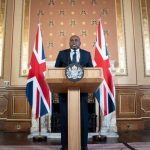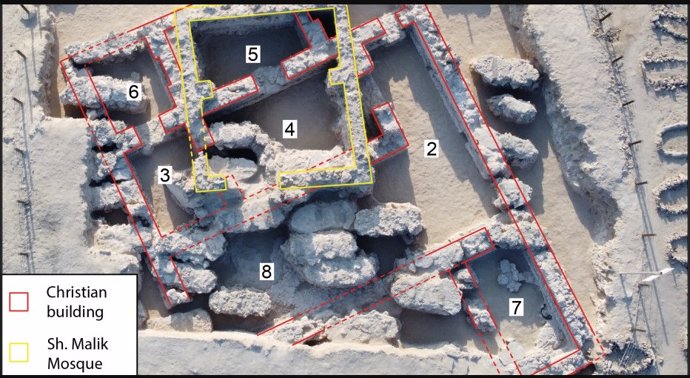The building survived because a mosque was later built on top of it. – UNIVERSITY OF EXETER
12 Jul. () –
Archaeologists have discovered in Bahrain one of the first Christian buildings in the Persian Gulf, the first physical evidence of a long-lost community.
Today, Christianity is not something that is usually associated with the Persian Gulf, but the Eastern Church, sometimes called the Nestorian Church, prospered there until a large-scale conversion to Islam began to occur after the religion was established in 610 AD.
Radiocarbon dating indicates that the buildingin Samahij, Bahrainwas occupied between the mid-4th century and the mid-8th century, when it was abandoned after the population converted to Islam.
Excavations by British and Bahraini archaeologists under a mound in a cemetery in the village revealed a large building with eight surviving rooms. These included a kitchen, a refectory or dining room, a possible workroom and three living rooms. It had survived because a mosque was later built over it.
The building may have been the palace of the bishop of the diocese of which Samahij was a part.called Meshmahig or Mašmahig in historical sources, and a corruption of “Samahij”. Records indicate that the relationship between Meshmahig and the central church authorities was not always smooth, as one bishop was excommunicated in 410, and in the mid-7th century another bishop was condemned for challenging the unity of the Church.
Previously, the handful of Christian buildings (churches, monasteries, residences) scattered around the Gulf were located in small, remote towns in Iran, Kuwait, the United Arab Emirates and eastern Saudi Arabia, most of later date. Samahij is different because it is located in the heart of a modern settlement.
The building was very well constructed with stone walls, plastered inside and with plaster floors. Plinths and holes indicated where doors and benches had been fixed internally, and the kitchen contained several hearths made from the bases or lids of amphorae as storage vessels.
The occupants had a good standard of livingThey ate pork, which disappeared after the Islamic conversion, fish, shellfish and various crops that are being analyzed.
The discovery of carnelian semi-precious stone beads and numerous pottery fragments of Indian origin indicate that They were involved in trade, especially with India.
The community also used glass objects, including small wine glasses, a custom that disappeared in the Islamic era. The dozen copper coins recovered by archaeologists suggest that They used coins minted in the Sassanid Empire.
Copper whirlwinds and needles were found in the building, so it is possible that textiles for use in worship were produced there.
The Christian identity of the inhabitants is shown by three plaster crosses found, two that would have decorated the building and one that could have been carried or kept as a personal souvenir, and by graffiti scratched into the plaster that includes part of what appears to be a Chrysostom and a fish, both early Christian symbols.
The building was excavated between 2019 and 2023 as part of a project jointly led by Professor Timothy Insoll of the University of Exeter’s Institute of Arabic and Islamic Studies and Dr Salman Almahari of the Bahrain Culture and Antiquities Authority.
Professor Tim Insoll said it’s a statement“We were surprised to discover that someone had also drawn part of a face on a pearl shell in bitumen, perhaps for a child who lived in the building.
“This is the first Physical evidence found of the Nestorian Church in Bahrain and provides a fascinating insight into how people lived, worked and prayed.”
A museum is now being built on the site to preserve and present this remarkable survival and is scheduled to open in 2025.









![[Img #74800]](https://thelatestnews.world/wp-content/uploads/2025/01/What-makes-the-HONOR-store-a-great-choice-for-buyers-150x150.jpg)



![[Img #74800]](https://thelatestnews.world/wp-content/uploads/2025/01/What-makes-the-HONOR-store-a-great-choice-for-buyers-300x200.jpg)

Add Comment